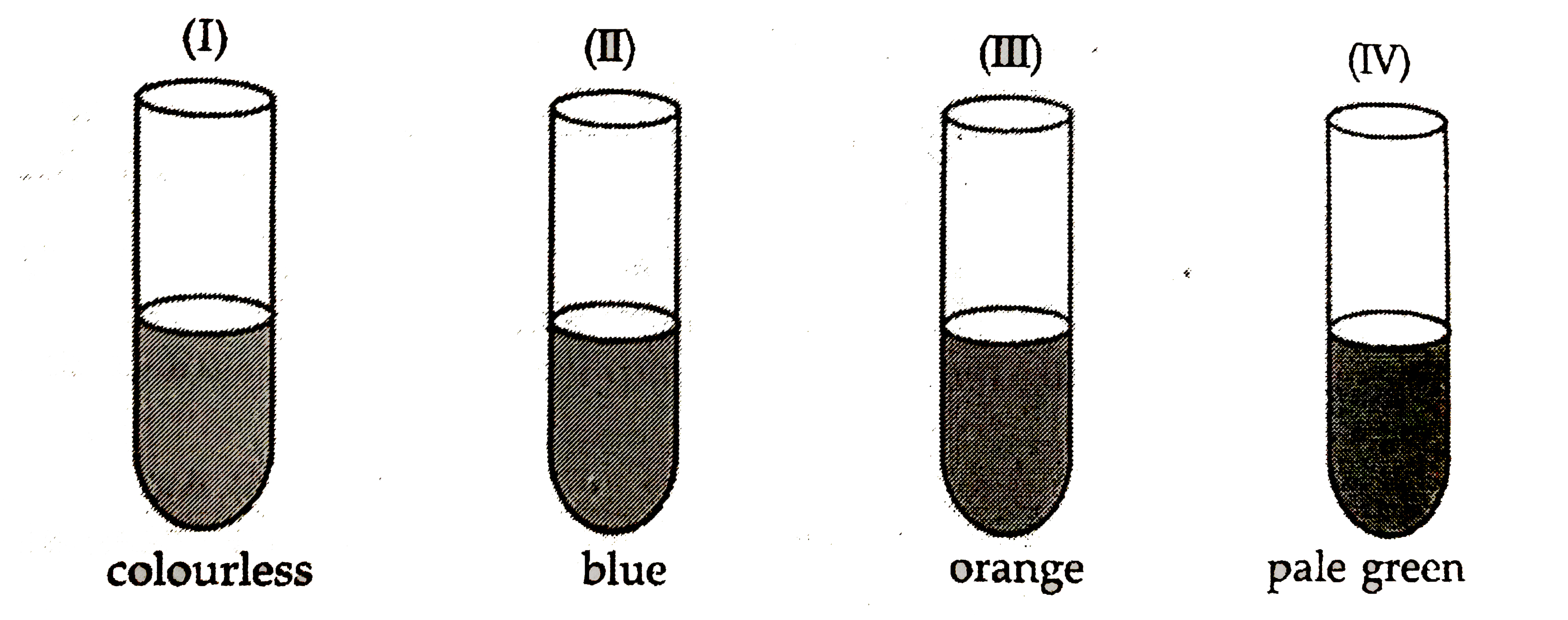A student took four test tubes I, II, III and IV containing aluminium sulphate, copper sulphate, ferrous sulphate and zinc sulphate solutions, respectively. He placed an iron strip in each of them. In which test tube, a brown deposit is formed?
A brown deposit is formed in test tube II because iron being less reactive does not displace metals from the solution of Al2(SO4)3,FeSO4 and ZnSO4 but it is more reactive than Cu. So, it displaces copper from CuSO4 and forms FeSO4 which is green in colour and a brown deposit of copper metal.

Topper's Solved these Questions
- PRACTICAL BASED QUESTIONSBOOK - VK GLOBAL PUBLICATIONCHAPTER - PRACTICAL BASED QUESTIONSEXERCISE - Experiment 3
4 Videos
- PRACTICAL BASED QUESTIONSBOOK - VK GLOBAL PUBLICATIONCHAPTER - PRACTICAL BASED QUESTIONSEXERCISE - Experiment 4
6 Videos
- PRACTICAL BASED QUESTIONSBOOK - VK GLOBAL PUBLICATIONCHAPTER - PRACTICAL BASED QUESTIONSEXERCISE - Experiment 15
4 Videos
- MANAGEMENT OF NATURAL RESOURCESBOOK - VK GLOBAL PUBLICATIONCHAPTER - MANAGEMENT OF NATURAL RESOURCESEXERCISE - HOTS (Higher Order Thinking Skills)
7 Videos
- SOURCES OF ENERGY BOOK - VK GLOBAL PUBLICATIONCHAPTER - SOURCES OF ENERGY EXERCISE - SHORT ANSWER QUESTIONS - II
16 Videos
Similar Questions
A student addd few pieces of aluminium metal to two test tubes A and B containing aqueous solutions of iron sulphate and copper sulphate. In the second part of her experiment, the added iron metal to another test tubes C and D containing aqueous solutions of aluminium sulphate and copper sulphate.
In which test tube or test tubes will she observe colour change? On the basis of this experiment, state which one is the most reactive metal and why ?
View SolutionA student addd few pieces of aluminium metal to two test tubes A and B containing aqueous solutions of iron sulphate and copper sulphate. In the second part of her experiment, the added iron metal to another test tubes C and D containing aqueous solutions of aluminium sulphate and copper sulphate.
In which test tube or test tubes will she observe colour change? On the basis of this experiment, state which one is the most reactive metal and why ?
View Solution
Knowledge Check
A student took four test tubes I,II,III and IV containing aluminium sulphate, copper sulphate, ferrous sulphate and zinc sulphate solutions respectively. He placed iron strips in each one of them. after some time he found a brown deposite formed in test -tube marked:
 AIBIICIIIDIV
AIBIICIIIDIVSandhya took three beakers A, B and C containing Zinc Sulphate, Silver Sulphate and Iron (II) Sulphate solutions respectively. Copper pieces were added to each beaker. The solution will appear blue in the case of:
ABeaker ABBeaker BCBeaker CDBeakers-B and CA student puts one big iron nail each in four test tubes containing solutions of zinc sulphate, aluminium sulphate, copper sulphate and iron sulphate. A reddish-brown coating was observed only on the surface of iron nail which was put in the solution of
Azinc sulphateBiron sulphateCcopper sulphateDaluminium sulphate.
A student addd few pieces of aluminium metal to two test tubes A and B containing aqueous solutions of iron sulphate and copper sulphate. In the second part of her experiment, the added iron metal to another test tubes C and D containing aqueous solutions of aluminium sulphate and copper sulphate.
In which test tube or test tubes will she observe colour change? On the basis of this experiment, state which one is the most reactive metal and why ?
View SolutionApparatus: Copper wire, iron nail, beaker or big test tube, etc.
Chemicals: Aqueous solutions of ferrous sulphate and copper sulphate.
Procedure: i. Take a clean copper wire and a clean iron nail.
ii. Dip the copper wire in ferrous sulphate solution and the iron nail in copper sulphate solution.
iii . Keep on observing continually at a fixed interval of time.
In which test tube a reaction has taken place?
View SolutionBeakers A, B and C contain zinc sulphate, silver nitrate and iron (II) sulphate solutions respectively. Copper pieces are added to each beaker. Blue colour will appear in case of
View SolutionA student took four test tubes containing solutions of different colours marked I,II, III and IV as shown here. The test tubes containing copper sulphate solution and ferrous sulphate could be the tubes:

View SolutionA student strongly heats hydrated ferrous sulphate salt in a dry test-tube. He would observe a :
View Solution
